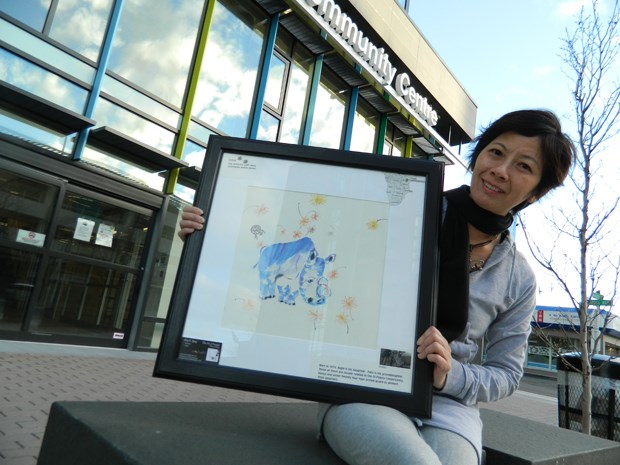It’s a painting of a Northern White Rhino named Sudan. He’s 41-years-old and one of just three left in the world.
“They feel like my babies,” says the Richmond artist.
Since she started researching the plight of rhinos being illegally poached about a year ago, Yueng has turned her talents as a freestyle Chinese painting instructor to the majestic, yet primordial looking creatures, dabbing delicate sheets of rice with water colours to capture their ungainly, yet graceful form.
In each painting of the rhinos, Yeung has placed ornate bracelets draped over their horns as a sign these animals should be revered for their mere presence and not the purported folklore-based “cures” that their horns have for a myriad of ailments.
That’s why Yeung, who was born in Hong Kong and has lived locally since 2000, is launching an exhibition of her rhino art called Tusk and Horn that debuts Jan. 13 at the recently opened City Centre Community Centre (5900 Minoru Blvd.).
“I am Asian, and I want to spread the word to everyone that this is not right,” she says. “The problem with using rhino horns comes mostly from the Asian community. And I want to make things right.”
Yeung said she hopes to draw attention to the continued poaching of rhinos through her art and focused on the remaining three Northern White Rhinos who live at the Ol Pejeta Conservancy in Kenya.
“They have the last three protected there with armed guards 24 hours a day,” Yeung says, adding she became interested in them when there were five. Two have since passed away from old age.
“It’s really sad. The remaining three are too old to produce any offspring, although the scientists are trying to find a way to fertilize the eggs from one of the females with a Southern White Rhino,” she says. “But when the last, pure, Northern White Rhino is gone, that’s the end.”
Yeung says she is also concerned with the other rhino species which are on the endangered species list.
“I want my work to be a wake up call for people here, raise awareness about rhino poaching and have it stopped,” she says. “This is the least I can do.
“This poaching is just nonsense.”
Illegal trade in endangered animal parts made headlines in Richmond last spring when a local antiques dealer was sentenced in a U.S. Federal Court to two and a half years in prison for smuggling half a million dollars worth of rhinoceros horns, elephant ivory and coral from the U.S. to Canada.
Tony (Xiao Ju)Guan was arrested in March 2014 as part of “Operation Crash,” a U.S.-wide crackdown on the illegal trafficking in rhinoceros horns, for his role in smuggling rhinoceros horns and items carved from elephant ivory and coral, from auction houses throughout the U.S. to Canada.
Guan was arrested after flying from YVR to New York and buying two endangered black rhinoceros horns from undercover special agents with the U.S. Fish and Wildlife Service at a storage facility in the Bronx, New York.
After purchasing the horns, Guan had the undercover agents drive him and a female accomplice to a nearby express mail store, where he mailed the horns to an address in Point Roberts, Wash.
In addition to the jail term, U.S. District Judge Laura Taylor Swain ordered Xiao Ju Guan, to forfeit wildlife items found during a search of his Richmond business, Bao Antiques on Alderbridge Way just east of No. 3 Road, the U.S. department of justice said.
Judge Swain noted Guan’s conduct “feeds demand for the slaughter of rare and already endangered species.”
— with files from the Vancouver Sun



